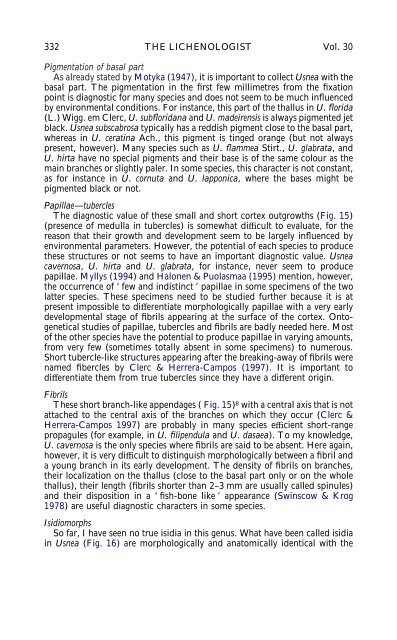SPECIES CONCEPTS IN THE GENUS USNEA (LICHENIZED ...
SPECIES CONCEPTS IN THE GENUS USNEA (LICHENIZED ...
SPECIES CONCEPTS IN THE GENUS USNEA (LICHENIZED ...
Create successful ePaper yourself
Turn your PDF publications into a flip-book with our unique Google optimized e-Paper software.
332 <strong>THE</strong> LICHENOLOGIST Vol. 30<br />
Pigmentation of basal part<br />
As already stated by Motyka (1947), it is important to collect Usnea with the<br />
basal part. The pigmentation in the first few millimetres from the fixation<br />
point is diagnostic for many species and does not seem to be much influenced<br />
by environmental conditions. For instance, this part of the thallus in U. florida<br />
(L.) Wigg. em Clerc, U. subfloridana and U. madeirensis is always pigmented jet<br />
black. Usnea subscabrosa typically has a reddish pigment close to the basal part,<br />
whereas in U. ceratina Ach., this pigment is tinged orange (but not always<br />
present, however). Many species such as U. flammea Stirt., U. glabrata, and<br />
U. hirta have no special pigments and their base is of the same colour as the<br />
main branches or slightly paler. In some species, this character is not constant,<br />
as for instance in U. cornuta and U. lapponica, where the bases might be<br />
pigmented black or not.<br />
Papillae—tubercles<br />
The diagnostic value of these small and short cortex outgrowths (Fig. 15)<br />
(presence of medulla in tubercles) is somewhat difficult to evaluate, for the<br />
reason that their growth and development seem to be largely influenced by<br />
environmental parameters. However, the potential of each species to produce<br />
these structures or not seems to have an important diagnostic value. Usnea<br />
cavernosa, U. hirta and U. glabrata, for instance, never seem to produce<br />
papillae. Myllys (1994) and Halonen & Puolasmaa (1995) mention, however,<br />
the occurrence of ‘ few and indistinct ’ papillae in some specimens of the two<br />
latter species. These specimens need to be studied further because it is at<br />
present impossible to differentiate morphologically papillae with a very early<br />
developmental stage of fibrils appearing at the surface of the cortex. Ontogenetical<br />
studies of papillae, tubercles and fibrils are badly needed here. Most<br />
of the other species have the potential to produce papillae in varying amounts,<br />
from very few (sometimes totally absent in some specimens) to numerous.<br />
Short tubercle-like structures appearing after the breaking-away of fibrils were<br />
named fibercles by Clerc & Herrera-Campos (1997). It is important to<br />
differentiate them from true tubercles since they have a different origin.<br />
Fibrils<br />
These short branch-like appendages ( Fig. 15) 8 with a central axis that is not<br />
attached to the central axis of the branches on which they occur (Clerc &<br />
Herrera-Campos 1997) are probably in many species efficient short-range<br />
propagules (for example, in U. filipendula and U. dasaea). To my knowledge,<br />
U. cavernosa is the only species where fibrils are said to be absent. Here again,<br />
however, it is very difficult to distinguish morphologically between a fibril and<br />
a young branch in its early development. The density of fibrils on branches,<br />
their localization on the thallus (close to the basal part only or on the whole<br />
thallus), their length (fibrils shorter than 2–3 mm are usually called spinules)<br />
and their disposition in a ‘ fish-bone like ’ appearance (Swinscow & Krog<br />
1978) are useful diagnostic characters in some species.<br />
Isidiomorphs<br />
So far, I have seen no true isidia in this genus. What have been called isidia<br />
in Usnea (Fig. 16) are morphologically and anatomically identical with the

















